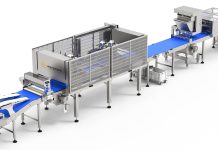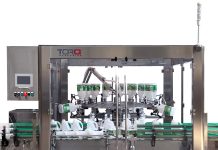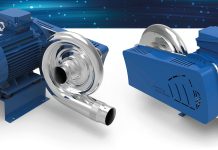
Washing and drying containers have different functions: safe capping, precise and durable label adhesion, no moisture inside packaging boxes
The market offers a great variety of technologies for washing and drying both bottles and cans. Modern washing-drying machines have compact dimensions, and can be easily added to in already existing lines, even with little available space. Moreover, they allow both washing (i.e. removal of dirt and scraps of glass processing from the cap, neck, shoulder, body and bottom of bottles), and total drying of bottles: cap and neck for a safe capping, body for a precise and durable label adhesion, and bottom to avoid moisture formation inside containers and to allow the bottle wrapping in cover paper.
Different versions
Both cylindrical or shaped washing and drying machines work at extremely different speeds (from 500 b/h to 20,000 b/h). Some machines are equipped with inverters for speed regulation, with conveyors with adjustable sides and transport chain for bottles, or with a section in which bottles are carried to the different washing and drying positions from a central intermittently rotating star. Bottle washing is generally performed mechanically by means of rotating brushes for bottle cap, body and bottom, which are wetted by water spray (not too hard if possible) ejected from properly oriented nozzles. The bottle elements can be washed simultaneously or separately (bottom and cap first, and body subsequently). Bottles are rotated in the opposite direction to the brushes. In this way, the rubbing effect produced by the ends of the brush bristles cleans even the most stubborn dirt. By rotating, brushes clean themselves with wash water which drags the dirt towards the machine drain. In almost all machines, the used brushes do not need to be replaced when the container format changes and they are self-cleaning since, through their rotation, the wash water drags the dirt towards the machine drain. Moreover, they are equipped with an independent inverter which allows regulating rotational speed. Bottle drying can be performed inside a tunnel where air distributors – adjustable in height, depth and inclination – are feeded by compression turbines for the production of heated air (temperature up to 45°C/50°C). Also in this case, bottles and caps can be dried together or separately(by compressed air only on the cap and by ventilators located on the sides of the belt conveyor). Ventilators can be regulated. The resulting flux is adherent to the bottle glass and drags water downwards, ensuring the perfect drying of bottle body. Cylindrical bottles can be mechanically rotated inside the dying tunnel. Completely automated, other machines are manufactured in different versions according to the required production per hour and to the type of container to be processed. They can perform several functions: washing with cold or hot water,

sterilizing through recycling water and sulphur dioxide. It is moreover possible to use such system to start the bottles through an associated recycling system made up of pump and filter. On the contrary, air-curtain machines with electric motor are particularly useful for container drying and for damp removal before labeling, drying and cleaning of ceramic and plastics, blowing and removing of scraps, sawdust and shavings, and machine cleaning. The machines equipped with an electric motor instead of compressed air reduce management costs by 80%-90%, and minimize noise. Centrifugal ventilators provide a powerful air flux while keeping low energy costs if compared to other ventilating systems such as the ones with compressed air or the electric ventilator with lateral tube. Coupled with air-curtain generators with “drop-like” section, they are optimized to avoid counter-pressure, and ensure high performances as for drying, cleaning and cooling of processed items. Their compact size allows and simplifies their positioning directly on production line. Air-curtain generators are available in extruded anodized aluminum or AISI 316 stainless steel. Every centrifugal ventilator can supply different generators. The outlet air temperature can be regulated and usually varies on a range from 70 up to 120 °C. For higher air pressures or speeds, it is only needed to regulate the outlet of the air-curtain. There is a whole range of benefits: the air flux is clean, uniform, high-speeded and with low noise emission, temperature is adjustable, installation is usually simple, and the machine is compact.
Washing and drying empty bottles
The situation is different when washing and drying empty bottles. Once bottles are positioned upside down either automatically(the pliers which have picked the bottle are inverted by 180° thanks to a purposely shaped tubular cam, by turning the bottle in vertical position, with its neck turned upside down and in correspondence of an injection nozzle) or manually in the corresponding cells, a water spray washes the bottles in order to remove any harmful residues. The injection duration can be adjusted according to the type of container to be processed. Machines can be equipped with a recovery basin, pump, and filter assembly, in order to use an alcoholic or sterilizing solution. The remaining part of the system is used for draining the container (just a few seconds). Afterwards, containers are unloaded or carried to the filling head through a conveyor belt.



